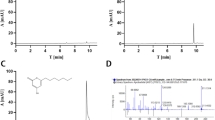Abstract
LIKE various β-lactamases, acylases and esterases1, the exocellular DD-carboxypeptidase-transpeptidase of Streptomyces R61 degrades benzylpenicillin and other β-lactam antibiotics2-4. The R61 enzyme, however, markedly differs from the other penicillin-degrading enzymes in causing fragmentation of the penicillin nucleus. By using 8-14C-benzylpenicillin (benzyl labelled) as substrate, one of the fragments produced was shown to be 14C-phenylacetylglycine5. The reaction with the R61 enzyme is also peculiar in that it is a slow process. This is because of the long half life of the stoichiometnc complex transitorily formed between the antibiotic and the enzyme. Thus, for example, the value of the half life for the complex formed with benzylpenicillin is 80 min in 10 mM phosphate buffer (pH 7.0) and at 37 °C. As breakdown of the complex proceeds, however, phenylacetylglycine (when benzylpenicillin is used as substrate) is released and the enzyme concomitantly recovers its ability to bind penicillin. We have now characterised the fragment (hereby designated as the Y product) arising from the thiazolidine ring of penicillin as a result of the fragmentation of the antibiotic molecule by the R61 enzyme.
Similar content being viewed by others
References
Abraham, E. P., Biosynthesis and Enzymic Hydrolysis of Penicillins and Cephalosporins (University of Tokyo Press, Tokyo, 1974).
Ghuysen, J. M., et al. Bull. Inst. Pasteur, 73, 101–140 (1975).
Frère, J. M., Leyh-Bouille, M., Ghuysen, J. M., and Perkins, H. R., Eur. J. Biochem., 50, 203–214 (1974).
Frère, J. M., Ghuysen, J. M., and Iwatsubo, M., Eur. J. Biochem., 57, 343–351 (1975).
Frère, J. M., Ghuysen, J. M., Degelaen, J., Loffet, A., and Perkins, H. R., Nature, 258, 168–170 (1975).
Clarke, H. T., Johnson, J. R., and Robinson, R., (eds), Chemistry of Penicillin, 471 and 469 (Princeton University Press, Princeton, New Jersey, 1949).
Hammarström, S., and Strominger, J. L., Proc. natn. Acad. Sci. U.S.A., 72, 3463–3467 (1975).
Marquet, A., Dusart, J., Ghuysen, J. M., and Perkins, H. R., Eur. J. Biochem., 46, 515–523 (1974).
Author information
Authors and Affiliations
Rights and permissions
About this article
Cite this article
FRERE, JM., GHUYSEN, JM., VANDERHAEGHE, H. et al. Fate of thiazolidine ring during fragmentation of penicillin by exocellular DD-carboxypeptidase-transpeptidase of Streptomyces R61. Nature 260, 451–454 (1976). https://doi.org/10.1038/260451a0
Received:
Accepted:
Issue Date:
DOI: https://doi.org/10.1038/260451a0
- Springer Nature Limited





